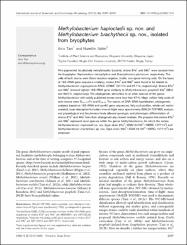| dc.contributor.author | Tani, Akio | |
| dc.contributor.author | Şahin, Nurettin | |
| dc.date.accessioned | 2020-11-20T16:19:24Z | |
| dc.date.available | 2020-11-20T16:19:24Z | |
| dc.date.issued | 2013 | |
| dc.identifier.issn | 1466-5026 | |
| dc.identifier.issn | 1466-5034 | |
| dc.identifier.uri | https://doi.org/10.1099/ijs.0.048215-0 | |
| dc.identifier.uri | https://hdl.handle.net/20.500.12809/3743 | |
| dc.description | Sahin, Nurettin/0000-0002-1049-6180; Tani, Akio/0000-0001-7685-9063 | en_US |
| dc.description | WOS: 000326426100026 | en_US |
| dc.description | PubMed ID: 23475343 | en_US |
| dc.description.abstract | Pink-pigmented, facultatively methylotrophic bacteria, strains 87e(T) and 99b(T), were isolated from the bryophytes Haplocladium microphyllum and Brachythecium plumosum, respectively. The cells of both strains were Gram-reaction-negative, motile, non-spore-forming rods. On the basis of 16S rRNA gene sequence similarity, strains 87e(T) and 99b(T) were found to be related to Methylobacterium organophilum ATCC 27886(T) (97.1% and 97.7%, respectively). Strains 87e(T) and 99b(T) showed highest 16S rRNA gene similarity to Methylobacterium gnaphalii 23e(T) (98.3 and 99.0%, respectively). The phylogenetic similarities to all other species of the genus Methylobacterium with validly published names were less than 97%. Major cellular fatty acids of both strains were C-18:1 omega 7c and C-18:0. The results of DNA DNA hybridization, phylogenetic analyses based on 16S rRNA and cpn60 gene sequences, fatty acid profiles, whole-cell matrix-assisted, laser-desorption/ionization time-of-flight mass spectrometry (MALDI-TOF/MS) analysis, and physiological and biochemical tests allowed genotypic and phenotypic differentiation of strains 87e(T) and 99b(T) from their phylogenetically closest relatives. We propose that strains 87e(T) and 99b(T) represent novel species within the genus Methylobacterium, for which the names Methylobacterium haplocladii sp. nov. (type strain 87e(T)=DSM 24195(T)=NBRC 107714(T)) and Methylobacterium brachythecii sp. nov. (type strain 99b(T)=DSM 24105(T)=NBRC 107710(T)) are proposed. | en_US |
| dc.description.sponsorship | Japan Society for the Promotion of ScienceMinistry of Education, Culture, Sports, Science and Technology, Japan (MEXT)Japan Society for the Promotion of Science [23688012]; Grants-in-Aid for Scientific ResearchMinistry of Education, Culture, Sports, Science and Technology, Japan (MEXT)Japan Society for the Promotion of ScienceGrants-in-Aid for Scientific Research (KAKENHI) [23688012] Funding Source: KAKEN | en_US |
| dc.description.sponsorship | This work was supported by a Grant-in-Aid from the Japan Society for the Promotion of Science (23688012) to A. T. We wish to thank Ms Y. Fujitani for excellent technical assistance and N. Nishimura for plant identification. | en_US |
| dc.item-language.iso | eng | en_US |
| dc.publisher | Microbiology Soc | en_US |
| dc.item-rights | info:eu-repo/semantics/openAccess | en_US |
| dc.subject | Methylobacterium haplocladii | en_US |
| dc.title | Methylobacterium haplocladii sp nov and Methylobacterium brachythecii sp nov., isolated from bryophytes | en_US |
| dc.item-type | article | en_US |
| dc.contributor.department | MÜ, Eğitim Fakültesi, Matematik Ve Fen Bilimleri Eğitimi Bölümü | en_US |
| dc.contributor.institutionauthor | Şahin, Nurettin | |
| dc.identifier.doi | 10.1099/ijs.0.048215-0 | |
| dc.identifier.volume | 63 | en_US |
| dc.identifier.startpage | 3287 | en_US |
| dc.identifier.endpage | 3292 | en_US |
| dc.relation.journal | International Journal of Systematic and Evolutionary Microbiology | en_US |
| dc.relation.publicationcategory | Makale - Uluslararası Hakemli Dergi - Kurum Öğretim Elemanı | en_US |


















